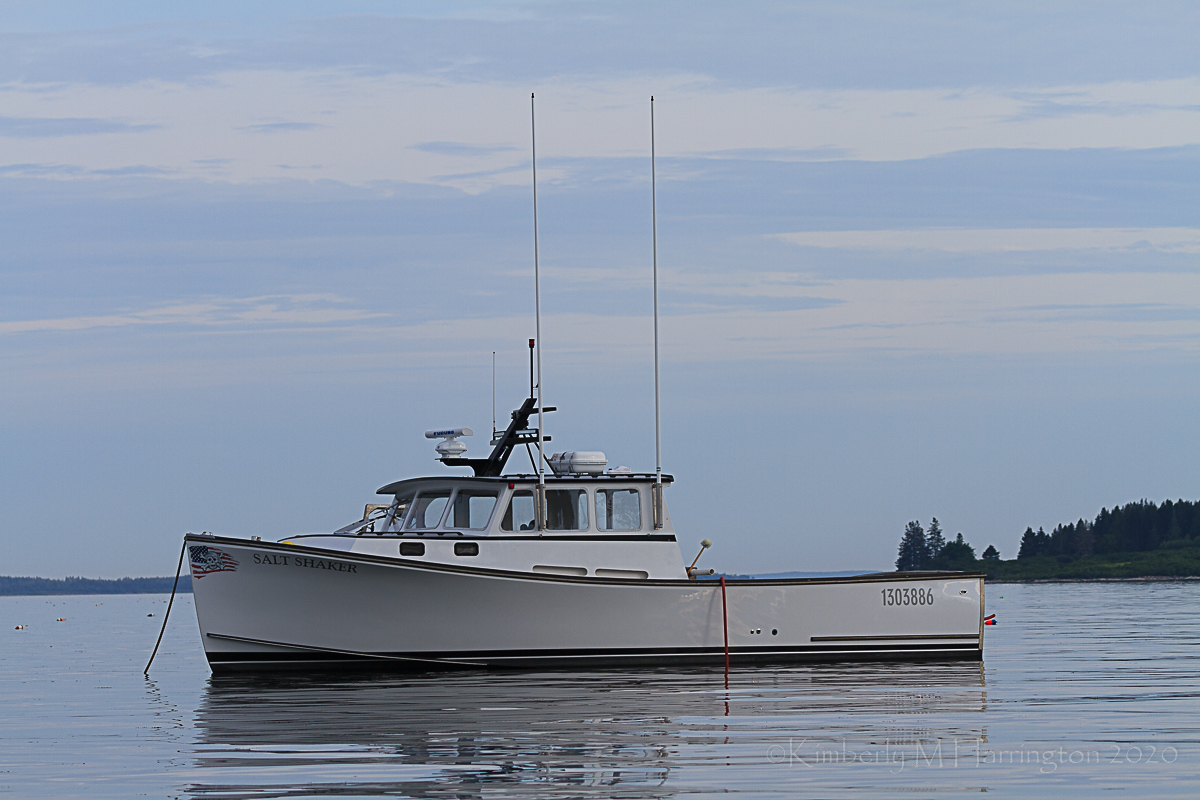This past winter and spring Gilbert Simmons and his son, Jason, operating as Simmons Boatworks in Friendship, Maine, finished off one lobster boat, instead of the usual two boats they’ve done in years past. Reducing the output by one was to create more time for them to be lobstering in the summer. The boat they launched in June is the Salt Shaker, a 42' x 15' Mussel Ridge for local fisherman Eugene Harrington.
It’s finished off using all composite construction. There’s a split wheelhouse, two lobster tanks underneath the platform, and V-bunks and shelving up forward. A small door is built into the transom. “The Mussel Ridge is pretty high sided,” says Gilbert. The door makes “it much easier to get aboard.”
The Salt Shaker is the second boat Simmons Boatworks has built for Harrington. The lobster boat it replaces is also a 42 Mussel Ridge. Horsepower is the major difference between the two boats; the new lobster boat comes with a 1,000-hp MAN, as opposed to Harrington’s previous 42 Mussel Ridge with a 700-hp Caterpillar C12. “He wanted more power. He wants to go fast,” says Simmons, adding, “He probably will be racing.”
Most boatbuilders have experienced delays in obtaining equipment for new boats and repair work, and Simmons Boatworks is no different, primarily when it comes to windows.
“Been able to get everything but windows,” says Simmons. Bomar windows for the Salt Shaker “were ordered months ago.” Thus the Salt Shaker went in the water with temporary windows. “When we get the Bomar windows, we’ll have to change them out — it’ll be expensive.”
Now that the Salt Shaker has been launched, it’s hard to say how many lobster traps the Simmonses will be hauling this summer. “The season doesn’t look good for lobstering,” says Simmons. “Between the [covid-19] virus and the whales, I don’t know,” he notes, referring to proposed federal rulings to protect the North American right whale by restricting the use of lobster traps.
Just in case Gilbert’s worst fears come to fruition and Maine’s lobster season isn’t as lucrative as it has been in the past, the Simmonses have a fallback option, a 38 Calvin hull with a 476-hp Caterpillar C9 that’s been sitting in the yard to be finished off as a spec boat. “I haven’t got to it,” says Simmons, “but I might work on it some in the summer and launch it in the fall.”
After a fire and explosion destroyed the R.P. Boatshop in Steuben, Maine, on March 1, 2010, along with all its Willis Beal designed R.P. molds, most fishermen assumed that was the end of the R.P. boat line. But they didn’t figure on Peter Taylor of Taylored Boats in Addison, Maine, who worked at R.P. Boats early in his career. Taylor, with the help of Willis Beal, has been creating the next generation of the Willis Beal designs by using existing R.P. hulls as a plug to create a mold and by lengthening and expanding hulls to make larger sizes.
The latest example is the 35-foot Karen Marie, an R.P.-built lobster boat out of Yarmouth, Maine, that Taylor figures was built at least 15 years ago. In early June, the Karen Marie was at Taylored Boats for repairs and to be extended to 38 feet by adding 3 feet at the stern, “following the lines that Willis had done years ago,” says Taylor.
A one-off splash mold was used to fabricate the stern extension, which was then fiberglassed and bolted to the hull. Then the now 38-foot Karen Marie was used to create a 38 Willis Beal mold. This follows the introduction of the Willis Beal 50 in October 2019.
“What we can make right today,” says Taylor “is the 35, 36, 37, 38, 40, 42 and 44, and the 50, though there’s no mold for that. Have to make it out of the 42,” which is done by adding 5 feet of beam to a 42 hull — pushing it out to 19' 6" — and lengthening the hull in the middle by 7 feet.
A new Willis Beal 44 with an 800-hp Scania is currently being built for a local lobsterman and should be completed by September or October. It will have a split wheelhouse with a baiting room on the back of the house.
Taylored Boats, like Simmons Boatworks, has experienced delays in getting equipment for new and existing boats. Taylor’s major hardware supplier went from being “a good supplier to a terrible supplier. I waited five to six weeks for multiple, multiple things.” In early June, Taylor had still not received a propeller for an existing fishing boat from another supplier that had been ordered in December. “Unless you are really a well-stocked boatbuilder, which I am not, it really can hurt.”







